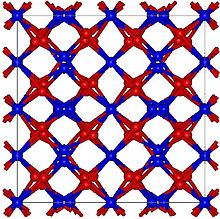Thallium(III) oxide

| |
| Names | |
|---|---|
| Other names
thallium trioxide, thallium sesquioxide
| |
| Identifiers | |
| ChemSpider | |
| ECHA InfoCard | 100.013.846 |
| EC Number |
|
CompTox Dashboard (EPA)
|
|
| Properties | |
| Tl2O3 | |
| Molar mass | 456.76 g/mol |
| Appearance | colourless solid |
| Density | 10.19 g/cm3, solid (22 °C) |
| Melting point | 717 °C |
| Boiling point | 875 °C decomp. |
| insoluble | |
| Structure | |
| Cubic, cI80[2] | |
| Ia-3, No. 206 | |
| Hazards | |
| NFPA 704 (fire diamond) | |
Except where otherwise noted, data are given for materials in their standard state (at 25 °C [77 °F], 100 kPa).
| |
Thallium(III) oxide is a chemical compound of thallium and oxygen. It occurs in nature as the rare mineral avicennite.[3] Its structure is related to that of Mn2O3 which has a bixbyite like structure. Tl2O3 is metallic with high conductivity and is a degenerate n-type semiconductor which may have potential use in solar cells.[4] A method of producing Tl2O3 by MOCVD is known.[5] Any practical use of thallium(III) oxide will always have to take account of thallium's poisonous nature. Contact with moisture and acids may form poisonous thallium compounds.
References
- ^ Weast, Robert C., ed. (1981). CRC Handbook of Chemistry and Physics (62nd ed.). Boca Raton, FL: CRC Press. p. B156. ISBN 0-8493-0462-8..
- ^ Otto H.H., Baltrasch R., Brandt H.J. (1993). "Further evidence for Tl3+ in Tl-based superconductors from improved bond strength parameters involving new structural data of cubic Tl2O3". Physica C. 215: 205. doi:10.1016/0921-4534(93)90382-Z.
{{cite journal}}: CS1 maint: multiple names: authors list (link) - ^ http://www.handbookofmineralogy.org/pdfs/avicennite.pdf Handbook of Mineralogy
- ^ Phillips R. J., Shane M. J., Switzer J. A. (1989). "Electrochemical and photoelectrochemical deposition of Thallium(III) Oxide thin films". Journal of Materials Research. 4: 923. doi:10.1557/JMR.1989.0923.
{{cite journal}}: CS1 maint: multiple names: authors list (link) - ^ D. Berry, R. T. Holm, R. L. Mowery, N. H. Turner, and M. Fatemi (1991). "Thallium(III) Oxide by Organometallic Chemical Vapor Deposition". Chemistry of Materials. 3 (1): 72–77. doi:10.1021/cm00013a019.
{{cite journal}}: CS1 maint: multiple names: authors list (link)

